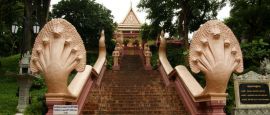This pseudo-Khmer style building, constructed by the French in 1917, houses an extensive collection of Khmer sculptures from the pre-Angkorian period (7th century) to the post-Angkorian period (14th century). In addition, there are bronze objects depicting religious activities, ancient Khmer ceramics and wooden statues. The art is displayed in chronological order and the English-speaking guides can help identify the subtle changes in style.
Things to see in Phnom Penh
Tourist offices
Address: 262 Monivong Boulevard, Phnom Penh, Cambodia
Tel: +855 23 218 585.
Opening Hours:
Mon-Sat 0800-1700.
tourismcambodia.comTourism Cambodia has an office located in the centre of Phnom Penh, above the Mittapheap Tours office. Head here to find a wealth of information on transport, accommodation and sights within the city. It also covers destinations across the country, allowing you to plan trips to Siem Reap, Battambang and beyond.
This stunning complex of buildings, built in traditional Khmer style, includes a Throne Hall and the intriguing iron house, which was donated by the French to King Norodom in 1876. The Throne Hall was used most recently in 2004 for the coronation of the new king, Norodom Sihamoni. Several pavilions have been added over the years. During the Khmer Rouge years, the former king, Sihanouk, was held prisoner in the palace. The royal family still reside in part of the complex.
This delightful pagoda, next to the Royal Palace, gets its name from the 5,000 silver tiles on its floor that weigh a formidable 6,000kg (6 tonnes). It’s home to several priceless Buddhas, including the Emerald Buddha, Wat Preah Keo, and a life-sized gold Buddha decorated in thousands of precious gems. The wall surrounding the temple is covered in murals depicting the epic tale of the Ramayana, although damaged in places. In the grounds are a number of stupas containing the ashes of former kings as well as a model of Angkor Wat.
A notorious prison under the Khmer Rouge, Tuol Sleng (known also as S-21) is a harrowing but essential stop off in Phnom Penh. Originally a high school, thousands were tortured and killed here in the 1970s under Pol Pot’s brutal regime. The school was surrounded by barbed wire and the classrooms were used to house manacled prisoners in crudely built cells. Other rooms contain a single bed frame and graphic photo of occupants left to die when the Khmer Rouge fled with the Vietnamese army approaching in January 1979. Most chilling are the photos of unidentified prisoners that cover the walls.
This is one of Phnom Penh's original and most important pagodas, dating from the 15th century and located close to the Royal Palace. It was once home to hundreds of monks and an extensive religious library, but suffered greatly at the hands of the Khmer Rouge. Many of the religious artefacts were thrown into the river during the Khmer Rouge years, but a few were eventually retrieved. The temple was built to house an important religious relic: an eyebrow hair from the Buddha.
Located on the top of a small hill, reached by a flight of steps with nagas (mythical serpents) on either side, this temple marks the spot where Phnom Penh was founded. It is one of the most important landmarks in the city, drawing a constant stream of visitors who come to pray for good luck. The interior is decorated with frescoes depicting the life of Buddha, and the story of the Ramayana.
This huge, lotus-shaped monument was built to celebrate independence from the French on 9 November 1953 and is also known as the Independence Monument. Now, it also commemorates Cambodia's war dead, and is the focus of celebrations and services on holidays such as Independence Day and Constitution Day. The adjacent park is popular with locals as a site for wedding photos, so look out for small groups with ornate umbrellas posing in the bright sun.
Do you have any Feedback about this page?
© 2025 Columbus Travel Media Ltd. All rights reserved. No part of this site may be reproduced without our written permission, click here for information on Columbus Content Solutions.








 You know where
You know where